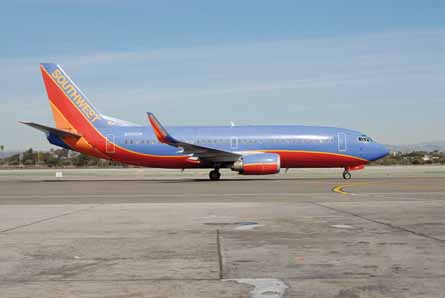US FAA officials are taking a close look at Boeing's manufacturing techniques after the fuselage of a Southwest Airlines 737-300 ruptured over Arizona on 1 April, prompting decompression and an emergency landing in Yuma.
Speaking at the MRO Americas conference in Miami, FAA administrator Randy Babbitt said: "People have leaped to the conclusion that it was fatigue. The airplane didn't have that many cycles on it so we're looking at other things. The manufacturing techniques. Boeing is very interested too. This is not good for anybody's business."
In the aftermath of the event, Boeing issued a service bulletin covering the operators of about 175 737-300/400/500s, and requiring inspections of fuselage structures to begin within five days for aircraft with more than 35,000 cycles, and within 20 days for those with 30,000 to 34,999 cycles. The FAA followed with an emergency airworthiness directive requiring repeated examinations every 500 cycles.
| |
|---|---|
"We've applauded Southwest for being very aggressive. They've taken a good hard look at their own operation. They've inspected their own airplanes. We have put together an airworthiness directive which they're in full compliance with," says Babbitt.
"And then we're asking everyone in the industry [to report on fatigue]. We have an aging aircraft rule, and we're just getting the data. That rule went into place, and they had about a year to report, and they're just now reporting. We're taking a hard look at that [and asking ourselves] 'are we looking at the right things here?'"
In his early morning speech at the conference, Babbitt highlighted the Southwest incident as an example of how air transport is, at its core, working.
"The airplane skin breached, and [the aircraft] depressurized. Well of course we at the FAA tell people 'when you're going to build an airplane you want to build it and you want to make sure that the integrity of the skin is always maintained'. But after you say that, then you say, 'and when that skin fails, when it fails, the airplane also has to keep its structural integrity and be operable'. And it did," says Babbitt.
"So again, we had a catastrophe, we had a breach. The airplane depressurized. The crew did precisely what they were supposed to do. Air traffic control did precisely what they were supposed to do. And the airplane did precisely what it was supposed to do. These are things that come from a well designed, well funded aviation system."
But Babbitt also used the platform to bemoan the 18 short-term extensions to FAA reauthorisation. "It isn't even funny," he says. While happy that the House and Senate have finally moved forward with longer-term legislation, the FAA remains concerned about funding levels for certain programmes, adds Babbitt.
Source: Air Transport Intelligence news

















